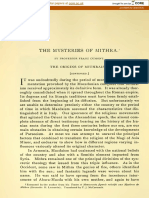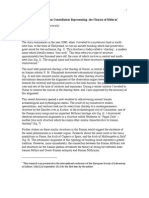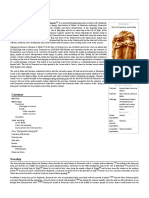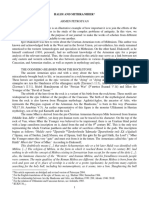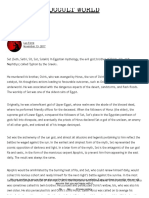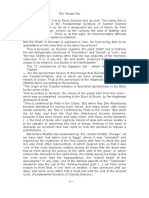Freemasonry - Mystery of Mithra
Freemasonry - Mystery of Mithra
Uploaded by
wez99Copyright:
Available Formats
Freemasonry - Mystery of Mithra
Freemasonry - Mystery of Mithra
Uploaded by
wez99Original Description:
Copyright
Available Formats
Share this document
Did you find this document useful?
Is this content inappropriate?
Copyright:
Available Formats
Freemasonry - Mystery of Mithra
Freemasonry - Mystery of Mithra
Uploaded by
wez99Copyright:
Available Formats
THE MYSTERY OF MITHRA by Harry Kenison M.M.
THE NEW AGE - APRIL 1961 MITHRAISM is of significant importance to Masons, for this early mystery religio n contains much that is symbolic of Masonry, and it is quite possible that Mithrai sm has been a contributing factor to several facets of Masonic wisdom. Mithra, the angel of god or heavenly light, as he was known in both the Vedas of India and old Persian documents, was also a war-like and conquering deity. He was special guardian of the "Great Kings," whom they involved prior to battle an d to whom they bound themselves by strong oaths. Mithraism expanded with the conquests of the Persian armies, and as the mighty Persian war machine spread victoriously through Syria, Chaldea, Galatia, and Asia Minor, the fame and influence of Mithra grew proportionately, Even after the defeat of Darius, the famed Persian ruler and general, Mithraism gained in popular acceptance in opposition to the Hellenizing culture of the Greeks. Mithra was not too highly regarded or accepted in Greece. This lack of populari ty was primarily based on the antipathy of the Greeks for the Persians as the resul t of early and well-remembered wars. This antipathy, however, was restricted almo st exclusively to Greece, for the domain of Mithra by the beginning of the Christia n era extended from the Indus River in the east to the Black Sea on the west and north. It was widely accepted in the plateau countries of Asia Minor, and came to be recognized by the Romans in the land of Paul's birth as the religion of th e Cilician pirates. The Roman, not being of the temperament to countenance for long the bold effront ery of the Cilician pirates, made short work of them, but the cult of Mithra was infectious, and the prisoners and slaves taken by the Romans quickly introduced the cult to the capital city. Thus, Mithraism, which was not widely acknowledge d outside the Orient during the Hellenic period, had by about the beginning of the second century become known throughout all Italy. The gospel of Mithra was well established in the city of Rome by the time Paul of Tarsus arrived there. At approximately this same time there was a general acceptance of Mithra by the army, and homage was paid him by the soldiers of the Third Legion. Contact with those in the Roman provinces throughout Asia Minor had further introduced Mithraism to both Roman citizens and soldiers alike. It was the mysteries of Dionysos that held an attraction for women at this time, largely because the ceremonies of Mithra were restricted to men. The cult of Mithra contained a special interest for Roman soldiers, for Mithra himself had been for centuries a god of battle, and his was a strong masculine cult appealin
g to reverential and superstitious soldiers. The soldiers required an assurance o f divine protection and courage in their constant contact with the foe. As the legions advanced, so did Mithraism. It soon became the recognized religion of t he Roman army and spread in two centuries to the farthest limits of the Roman Empir e. As the Roman legions forced their way into Germany, France and Britain, they wer e accompanied by groups of builders or masons who erected bridges, aqueducts, and fortifications as demanded by the soldiers or by the provinces they occupied. It is, then, possible that the similarity between some aspects of Masonry and Mithra could stem from this source. Little is known of the secret ceremonies of Mithra, and much that we have on the mystery has been deduced from the little factual evidence and is not entirely reliable. We are aware, however, that the worship of Mithra was no simple ceremony or initiation. Knowledge of this has been taken from prejudiced Christ ian sources opposed to the competitive cult of Mithra. They have indicated Mithraism consisted of seven stages or degrees, ranging from the lowest, the Raven, to the highest, the Father or Pater. Between these two grades were the degrees known a s Occult, Soldier, Lion, Persian, and Courier of the Sun. The initiation ceremonies have been described as beginning somewhat as follows: In the first degree the initiate wears the mask of the raven, and, enveloped in total darkness, he enters a cavern which is intermittently illuminated by flashe s of light representing lightning. In the occult ceremony he wears a veil and enters a door into a den of tigers, hyenas, and other simulated wild beasts. Th e initiate was presented a mask for each degree and conducted through several caverns in which methods were employed to instill fear and horror. In the seven th cavern, the darkness was changed to light, and the initiate was brought before t he chief priest, who was seated on a splendid throne and surrounded by assistant dispensers of the mysteries. He was also subjected to a grim fast, required to s wan a raging torrent, and exposed to the solitary terror of the desert wilderness. I t is said that be was finally beaten with rods and then buried up to the neck in s now. It is known that the Christian Fathers especially delighted in elaborating and condemning these rites and to expose them as "tortures" and the "eighty punishments" by water, fire, frost, hunger, thirst, and prolonged journeyings of increasing hardships and severity. The candidates took oaths of binding secrecy and were given an obligation which included sacred words known only to the members of the cult. The initiate was presented with a conical cap, loose tunics on which were depicted the celestial constellations, a belt containing the representations of the Zodiac, a pastoral
staff, and a golden serpent was placed on his bosom as a symbolic sign that he had been regenerated and initiated as a disciple of Mithra. Outstanding among the ceremonies of Mithra was a simulated murder, apparently performed on the candidate. It is supposed that death was the logical preliminary to a renewal of life and the possible representation of a transvaluation of all values. The priests of the early regeneration ceremonies acknowledged that only the select few among the initiates could master the ultimate secrets embodied in them. Murder was an obvious start toward a regeneration, in fact so apparent that it is said the emperor Commodus polluted the rites by a real murder when a certain thing was to be done for the sake of inspiring terror, probably in the third, or soldier, grade of the initiation. Also distinctive in the Mithraic ceremonies were baptism and ablutions of variou s sorts. Two types were the marking of the forehead and complete immersion, and i t is believed that they promised purification from guilt. The Christian Fathers, quick to notice the similarity, charged the devil with plagiarism. Provision was also made in the Mithraic ritual for the nourishing of a new spiritual life. At initiation, honey was placed in the mouth of the candidate, in both the Lion and the Persian grades of initiation. It was also customary to put honey in the mouths of new-born children; so in Mithraism the spiritually new-born were fed honey, it is said. Honey was of both mystical and practical value for the priests of Mithra. There is archaeological evidence indicating a communion including bread and wine , of which the Mithraic initiates partook. The bread consisted of tiny leaves, each distinctively marked with a cross. The participants ate the bread and then drank the wine from a cup. The Christians of the day, noting the likeness, accus ed the demons of thievery. Both ceremonies, Christian and Mithraic, were believed to have been memorial services celebrating the divine, and it is known that Mithra, at the close of his redemptive career and just before his ascension to heaven, partook of a last supper with his companions. The conception of Mithra himself was an ethical one, his name in Sanskrit meant "Friendship," and in the Avesta "Compact." As a result of Mithra's alliance with Zarathustra, his ethical character was accentuated and he was a special guardian of truth and light as opposed to evil or darkness. There were also certain commandments which the candidates were careful to observe to assure salvation with Mithra or the sun, with which he was identified. Mithraism has shown that the cult offered its devotees the hope of immortality and an assurance of victory in the struggle for life. Feeding the initiate honey and his participation in a sacramental communion both stressed outwardly the ide a that initiation was a rebirth to a new life. We are aware that the priests retained the higher secrets of the mysteries for themselves or those chosen to receive them. It is possible that the mysteries of Mithra represented the rebirth of a new philosophy of life, long hidden among
men and vitiated and obscured by them. It could be that this philosophy still awaits a time to emerge again, and bring out of the earth of materialism the living philosophy of a new age dedicated to the realistic rather then to the supernatural."
You might also like
- Rashi On Genesis - en - Pentateuch With Rashi's Commentary by M. Rosenbaum and A.M. Silbermann, 1929-1934.plainDocument229 pagesRashi On Genesis - en - Pentateuch With Rashi's Commentary by M. Rosenbaum and A.M. Silbermann, 1929-1934.plainnestorsouza36No ratings yet
- Believer Loveworld 1Document13 pagesBeliever Loveworld 1Agat100% (3)
- Maria Woodworth EtterDocument4 pagesMaria Woodworth EtterBisi TeruNo ratings yet
- Words of Jesus ESVDocument51 pagesWords of Jesus ESVBecky Jo Kaufmann-SchwarzNo ratings yet
- Jesus Was CaesarDocument2 pagesJesus Was CaesarDivus100% (2)
- Sanctus Illuminatus 2014 Catalog of ClassesDocument15 pagesSanctus Illuminatus 2014 Catalog of ClassesCarlos Antonio De Bourbon-MontenegroNo ratings yet
- Urim and ThummimDocument1 pageUrim and ThummimAnonymous NW5yAwcImPNo ratings yet
- The Genius of MithraismDocument7 pagesThe Genius of MithraismhNo ratings yet
- Mysteries of MithraDocument9 pagesMysteries of MithraAnu HasanNo ratings yet
- The Legacy of MithraismDocument11 pagesThe Legacy of MithraismMathieu RBNo ratings yet
- Swastika Constellation in The Sky... Very AncientDocument16 pagesSwastika Constellation in The Sky... Very AncientLuis Vizcaíno100% (1)
- MithraDocument4 pagesMithraMathieu RBNo ratings yet
- Julius Evola - The Symbols of Aryan Tradition: EagleDocument33 pagesJulius Evola - The Symbols of Aryan Tradition: EaglevallathsNo ratings yet
- SerapisDocument5 pagesSerapisОктай СтефановNo ratings yet
- 1 Dark Gods in AntiquityDocument8 pages1 Dark Gods in AntiquityUgjtlNo ratings yet
- Is Freemasonry Homosexual Cult?: by Leonardo ServadioDocument4 pagesIs Freemasonry Homosexual Cult?: by Leonardo Servadioagam husenNo ratings yet
- NS 6 - 240-260 - Eagle and Serpent in ZA - D. S. ThatcherDocument21 pagesNS 6 - 240-260 - Eagle and Serpent in ZA - D. S. ThatcherTG-DOXANo ratings yet
- 1919 Guthrie Pythagoras Source Book and Library PDFDocument368 pages1919 Guthrie Pythagoras Source Book and Library PDFAnonymous oCMP2bxdKiNo ratings yet
- An Examination of The Masonic RitualDocument21 pagesAn Examination of The Masonic RitualgayatrixNo ratings yet
- On The Zoroastrian Temple Cult of FireDocument13 pagesOn The Zoroastrian Temple Cult of Fireahmad13601360No ratings yet
- SugaarDocument2 pagesSugaarEmry Kamahi Tahatai Kereru100% (1)
- Prince Khamuas and Si-OsiriDocument24 pagesPrince Khamuas and Si-OsiricrdewittNo ratings yet
- WORLD WAR THREE (ENGLISH) V.M. Samael Aun Weor English TranslationDocument1 pageWORLD WAR THREE (ENGLISH) V.M. Samael Aun Weor English TranslationPrecisioneticaNo ratings yet
- Baphomet: Vamperess of The Dark GodsDocument2 pagesBaphomet: Vamperess of The Dark GodsAlice vythica100% (1)
- Zeus HamDocument10 pagesZeus HamAngela EhlhardtNo ratings yet
- Ainsworth, The Assyrian Origin of The IzedisDocument35 pagesAinsworth, The Assyrian Origin of The IzedisleonidoNo ratings yet
- Ancient Society: Or, Researches in the Lines of Human Progress from Savagery, through Barbarism to CivilizationFrom EverandAncient Society: Or, Researches in the Lines of Human Progress from Savagery, through Barbarism to CivilizationNo ratings yet
- Mars KarakaDocument3 pagesMars KarakamatriNo ratings yet
- Dumuzid È TamuzDocument9 pagesDumuzid È TamuzIrmãoIaorrúchuaNo ratings yet
- Crist & Indian GodDocument81 pagesCrist & Indian GodHarish Kumar MahavarNo ratings yet
- The Sabians of HarranDocument5 pagesThe Sabians of Harranblue_july2000100% (1)
- G.R.S. Mead - Echoes From The Gnosis Vol. V - Mysteries of MithraDocument101 pagesG.R.S. Mead - Echoes From The Gnosis Vol. V - Mysteries of MithraNico Ouwehand100% (1)
- Is Psalm 110 CanaaniteDocument6 pagesIs Psalm 110 CanaaniteJoshuaJoshuaNo ratings yet
- The Role of The Pentagrams in The Globe's ArchitectureDocument29 pagesThe Role of The Pentagrams in The Globe's ArchitectureRichter, JoannesNo ratings yet
- On Mysticism and Esoteric Ism Among The Zoroastrians - James R. RussellDocument23 pagesOn Mysticism and Esoteric Ism Among The Zoroastrians - James R. RussellMaani GharibNo ratings yet
- Schwartz - 2009 - Apollo and Khshathrapati The Median Nergal at XanthosDocument6 pagesSchwartz - 2009 - Apollo and Khshathrapati The Median Nergal at XanthosFarhad Aslani100% (1)
- Rest and Violence in The Poem of ErraDocument7 pagesRest and Violence in The Poem of ErraJakeukalane Milegum Firisse100% (2)
- Path of The SerpentDocument3 pagesPath of The SerpentBorja Rodríguez MelaraNo ratings yet
- The Devil'S Own: Thoughts On Ormuzd and AhrimanDocument7 pagesThe Devil'S Own: Thoughts On Ormuzd and Ahriman20145100% (2)
- Temple Mountain: The Original Myth, the Final Frontier, #3From EverandTemple Mountain: The Original Myth, the Final Frontier, #3No ratings yet
- Fragment From Osiris Chapel DenderaDocument18 pagesFragment From Osiris Chapel DenderaLuigi Tripani100% (1)
- Discrediting Ahura Mazda S Rival The Ori PDFDocument91 pagesDiscrediting Ahura Mazda S Rival The Ori PDFimperatorgothicusNo ratings yet
- Hathor (: Pyramid TextsDocument2 pagesHathor (: Pyramid TextsRegie Rey Agustin100% (1)
- Opening of The Mouth CeremonyDocument7 pagesOpening of The Mouth CeremonyJaredPerdomoCerratoNo ratings yet
- Priests Goddess 1996Document36 pagesPriests Goddess 1996Julio CesarNo ratings yet
- Haldi and Mithra Mher PDFDocument11 pagesHaldi and Mithra Mher PDFAlireza EsfandiarNo ratings yet
- Sleepi Eye of HorusDocument6 pagesSleepi Eye of Horusapi-270027373No ratings yet
- Set - OCCULT WORLDDocument8 pagesSet - OCCULT WORLDRed YoungNo ratings yet
- Pre Islamic PaganismDocument12 pagesPre Islamic Paganisminayat1No ratings yet
- The Gnostics and Their RemainsDocument356 pagesThe Gnostics and Their RemainsFernando Rossi100% (1)
- Death of The Aryan Invasion Theory - Stephen KnappDocument20 pagesDeath of The Aryan Invasion Theory - Stephen KnappSaptarshi Roy0% (1)
- 1 - Johfra and The Signs of The Zodiac (Escorpio y Sagitario)Document7 pages1 - Johfra and The Signs of The Zodiac (Escorpio y Sagitario)Marcos Alejandro Canales PiccoloNo ratings yet
- Abyzou - WikipediaDocument2 pagesAbyzou - WikipediaNyx Bella DarkNo ratings yet
- Ares Mars and The Others PDFDocument8 pagesAres Mars and The Others PDFcodytlseNo ratings yet
- Muwa Idūn Al Dururz (The Unitarian Druze)Document53 pagesMuwa Idūn Al Dururz (The Unitarian Druze)HELUWATNo ratings yet
- Key To VedasDocument68 pagesKey To Vedassunni (aamil) spiritual healerNo ratings yet
- The God Serapis 2008Document22 pagesThe God Serapis 2008አቤ dontagonizeorganizeNo ratings yet
- Inscriptional Evidence For Mahabharata TimesDocument7 pagesInscriptional Evidence For Mahabharata TimesovikbasuNo ratings yet
- Seven Mithraic Grades: An Initiatory or Priestly Hierarchy?: Ale ChalupaDocument13 pagesSeven Mithraic Grades: An Initiatory or Priestly Hierarchy?: Ale ChalupaTóth AndrásNo ratings yet
- René Guénon and InitiationDocument6 pagesRené Guénon and Initiationabaris13No ratings yet
- Zoroastrian Survivals in Iranian FolkloreDocument12 pagesZoroastrian Survivals in Iranian Folklorezzz222222No ratings yet
- The "Seventy-Two: (... ), The God of Gods, Who Reigns by Means of Laws and Whose Quality IsDocument11 pagesThe "Seventy-Two: (... ), The God of Gods, Who Reigns by Means of Laws and Whose Quality IsAndy SovagaNo ratings yet
- Wages, Josef (English TR.) - Better Than Horus, or The Seven Hows and Whys (1784)Document41 pagesWages, Josef (English TR.) - Better Than Horus, or The Seven Hows and Whys (1784)Quibus_Licet50% (2)
- The Setian Pyramid TextsDocument7 pagesThe Setian Pyramid TextsMoisés Cornejo100% (1)
- Howto TriforceDocument1 pageHowto Triforcewez99No ratings yet
- Altan Vesci LLO Burnton Octovali S Genni Stora Lendi Forma Wosenfeld FardestoDocument1 pageAltan Vesci LLO Burnton Octovali S Genni Stora Lendi Forma Wosenfeld Fardestowez99No ratings yet
- HOUSE OF LORDS - The UK and The Future of The Western Balkans PDFDocument117 pagesHOUSE OF LORDS - The UK and The Future of The Western Balkans PDFwez99No ratings yet
- Zapisnik Aca Stefanovic 2018-01-30Document5 pagesZapisnik Aca Stefanovic 2018-01-30wez99No ratings yet
- GIPE 002309 Contents PDFDocument17 pagesGIPE 002309 Contents PDFwez99No ratings yet
- How-To Kill A Process On The Windows Command-LineDocument3 pagesHow-To Kill A Process On The Windows Command-Linewez99No ratings yet
- Windows XP CustomizationDocument7 pagesWindows XP Customizationwez99No ratings yet
- Which Windows Do I Choose?: Comparing The Operating SystemsDocument4 pagesWhich Windows Do I Choose?: Comparing The Operating Systemswez99No ratings yet
- Practical Steps On Soul WinningDocument2 pagesPractical Steps On Soul Winningadelani_oniNo ratings yet
- Tui Leh Thagau Ah Pianthakna Diktak Laneitam?Document301 pagesTui Leh Thagau Ah Pianthakna Diktak Laneitam?C Knox JarmonNo ratings yet
- Saint Kirstos Semra's Hagiography 2011 de BirhanDocument11 pagesSaint Kirstos Semra's Hagiography 2011 de BirhanDe Birhan BlogspotNo ratings yet
- Beyond Ourselves: - Catholic VoicesDocument2 pagesBeyond Ourselves: - Catholic VoicesTheLivingChurchdocsNo ratings yet
- Pray Like ThisDocument2 pagesPray Like Thisapi-17579961No ratings yet
- Activity 2 The Nature and Attributes of God 2Document2 pagesActivity 2 The Nature and Attributes of God 2Lia Sophia ContrerasNo ratings yet
- Lisekhona Yini Ithemba Ngomhlaba?Document16 pagesLisekhona Yini Ithemba Ngomhlaba?alwandethembalethu10No ratings yet
- Demonic Visions: Demonic Visions: A Chapter From Ibn Taymiyyah'sDocument5 pagesDemonic Visions: Demonic Visions: A Chapter From Ibn Taymiyyah'sHamza SialeNo ratings yet
- David J. A. Clines, Tamara C. Eskenazi Telling Queen Michals Story An Experiment in Comparative Interpretation JSOT Supplement 1991 PDFDocument305 pagesDavid J. A. Clines, Tamara C. Eskenazi Telling Queen Michals Story An Experiment in Comparative Interpretation JSOT Supplement 1991 PDFVeteris Testamenti LectorNo ratings yet
- The Ten Avatars of Vishnu - A GuideDocument5 pagesThe Ten Avatars of Vishnu - A GuidesabNo ratings yet
- Hanukkah Hoax 2015Document1 pageHanukkah Hoax 2015Rogelio Martinez100% (1)
- The Seerah of Prophet Mohammad - Arabia Before Muhammad (Saw)Document10 pagesThe Seerah of Prophet Mohammad - Arabia Before Muhammad (Saw)FriedIqbalAtherNo ratings yet
- Solymi, MarnicheDocument18 pagesSolymi, MarnicheDana ParkerNo ratings yet
- 01 - "The Forgotten Dream"Document12 pages01 - "The Forgotten Dream"Cases M7No ratings yet
- Mornings With Jesus Epdf FinalDocument60 pagesMornings With Jesus Epdf FinalEreeNo ratings yet
- Overcoming The Spirit of BalaamDocument16 pagesOvercoming The Spirit of Balaambabasami100% (1)
- ELLIS DAVIDSON Thors HammerDocument18 pagesELLIS DAVIDSON Thors HammerBoppo Grimmsma100% (1)
- Jesusyouth Jesusyouth: International Newsletter International NewsletterDocument16 pagesJesusyouth Jesusyouth: International Newsletter International Newsletterjyjc_admNo ratings yet
- Family As A FlowerDocument32 pagesFamily As A FlowerCristine Jameica RivarezNo ratings yet
- Guru Nanak's Message To Mankind - Sher Singh, MSC, KashmirDocument7 pagesGuru Nanak's Message To Mankind - Sher Singh, MSC, KashmirSikhDigitalLibraryNo ratings yet
- The GCT in ScriptureDocument5 pagesThe GCT in ScripturemarkspsNo ratings yet
- What Is God's Primary Purpose For Marriage?Document5 pagesWhat Is God's Primary Purpose For Marriage?OFOSU ANIMNo ratings yet
- Final TestDocument6 pagesFinal TestAlondra AlvaradoNo ratings yet
- Muslim Scholar Quotes The Quran Saying That God Gave The Land To IsraelDocument4 pagesMuslim Scholar Quotes The Quran Saying That God Gave The Land To IsraelRichard BaliliNo ratings yet








